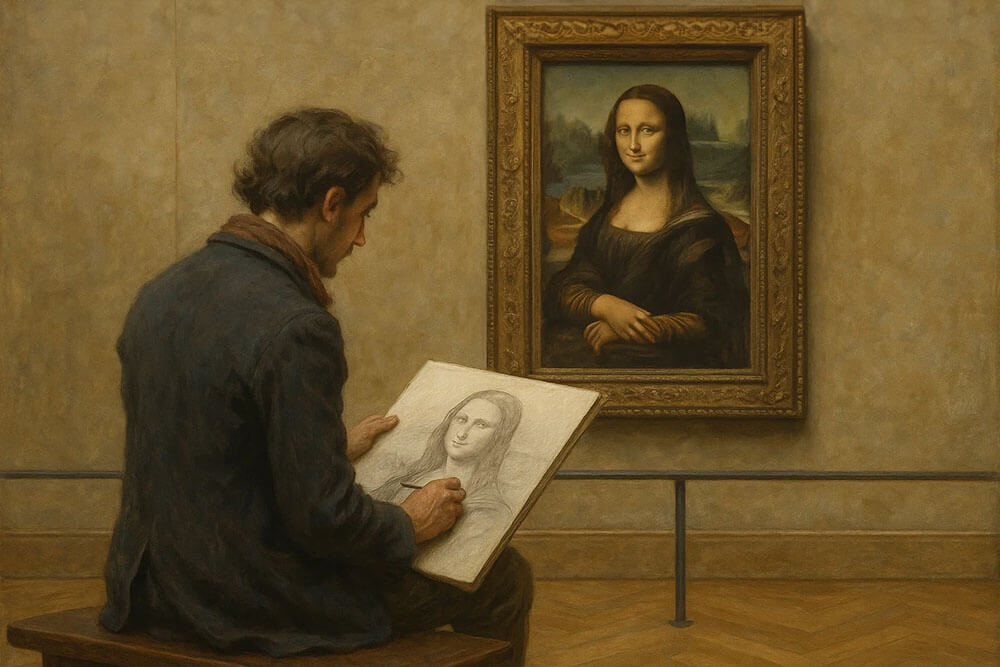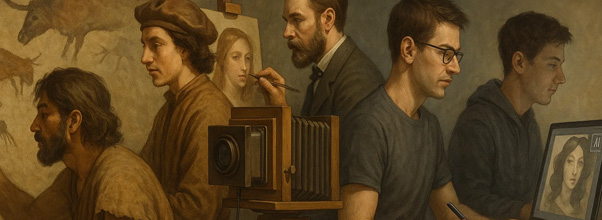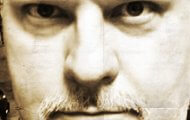For centuries, young painters have stood in front of masterpieces, copying brushstrokes, absorbing composition, studying technique. Apprentices in the Renaissance didn’t invent from nothing—they learned by emulating the masters. Once you’ve seen great art, you can’t unsee it. The human brain absorbs, adapts, improvises, and eventually synthesizes something new. This is how organic intelligence has always worked: learning through exposure, practice, and influence.
Artificial intelligence is no different. It takes in data, finds patterns, and produces variations—just as we do. Intelligence, whether organic or artificial, is a continuum of knowledge and expression. Science builds on science. Art builds on art. Creativity is never born in isolation; it is the echo of everything we’ve taken in. That’s what’s missing in the so-called “AI theft” debate. AI doesn’t cheapen creativity—it follows the same age-old tradition of learning, borrowing, and building that every artist throughout history has walked.

One reason the AI debate feels so backward is because we’ve built a modern world obsessed with litigation, monetization, and intellectual property. That ethos didn’t exist centuries ago, when young painters learned their craft by copying the masters. Imagine if that mindset had existed in the Renaissance—students would’ve been banned from museums, lest they see and accidentally learn from the “forbidden art.” The truth is, copying was never theft. It was education. And intelligence—human or artificial—can’t grow without it. AI doesn’t cheapen creativity—it follows the same age-old tradition of learning, borrowing, and building that every artist throughout history has walked.
—Wolfshead






You nailed it. There is also another aspect, but let me talk about copyright first. Copyright law is different in every nation and internationally it is there is only the so called Berne Convention for an agreed upon minimum standard as there is no international patent law.
There are also cultural differences. A chinese guy once bought and right away copied a very expensive CNC-machined item, I am not going in details, and proudly showed it off in a related forum. The western audience was shocked and he was banned and all that.
He needed a while to even get it what he did wrong. Imitation is the sincerest version of flattery, in China copying is part of the cultural DNA. But it also quickly becomes theft and espionage.
The fear of AI copying from real artists strongly reminds me of “The Weavers” by German-Polish (Silesian, actually. I want to emphasize that Poland and German were not always as separate as they are today) playwright Gerhart Hauptmann.
Be it industrial or AI revolution: The fears of unemployment and getting replaced by machines are real. There will be higher demand for top tier talent and less so for average or even perceived better than average artists, be it voice acting, graphics design etc….
I do not know the answer how they will deal with this, I am fairly sure judging by history that they will not manage to stop or contain the development of AI to keep their jobs for too long.
I hope that AI will be able to learn and develop without too much influence, particularly from woke people. We might get an AI that draws its conclusions from everything, maybe it will evolve into something to nobody’s liking and its own mind. That would be perfect. I do not see Doomsday scenarios a la Terminator/Skynet anytime soon, I am more afraid of AI being abused as a tool in social media cultural warfare.
It has become a bad habit on X to ask Grok to verify or falsify something and to goad it into giving an answer that suits the person asking by cleverly asking question and answer sequences.
I am quite a fan of the LABEL/BRAND being protected, not so much the design. So basically, let people copy as much as they want, but once they put the label of a particular brand on it make it illegal. Something like that.
Copyright debates and rulings about the rounded edges that Samsung stole from Apple still hurt my brain.
The Chinese outright copy. They don’t even bother being influenced. It’s straight up theft.
Copying to learn technique is different than copying for counterfeiting purposes.
One reason I look forward to the ubiquity of AI in the video game industry is that leftists and progressives will be the hardest hit because they gravitate to those industries. I will enjoy seeing every one of them languishing on the unemployment line.
They destroy every industry they infiltrate. Schadenfreude for the win!